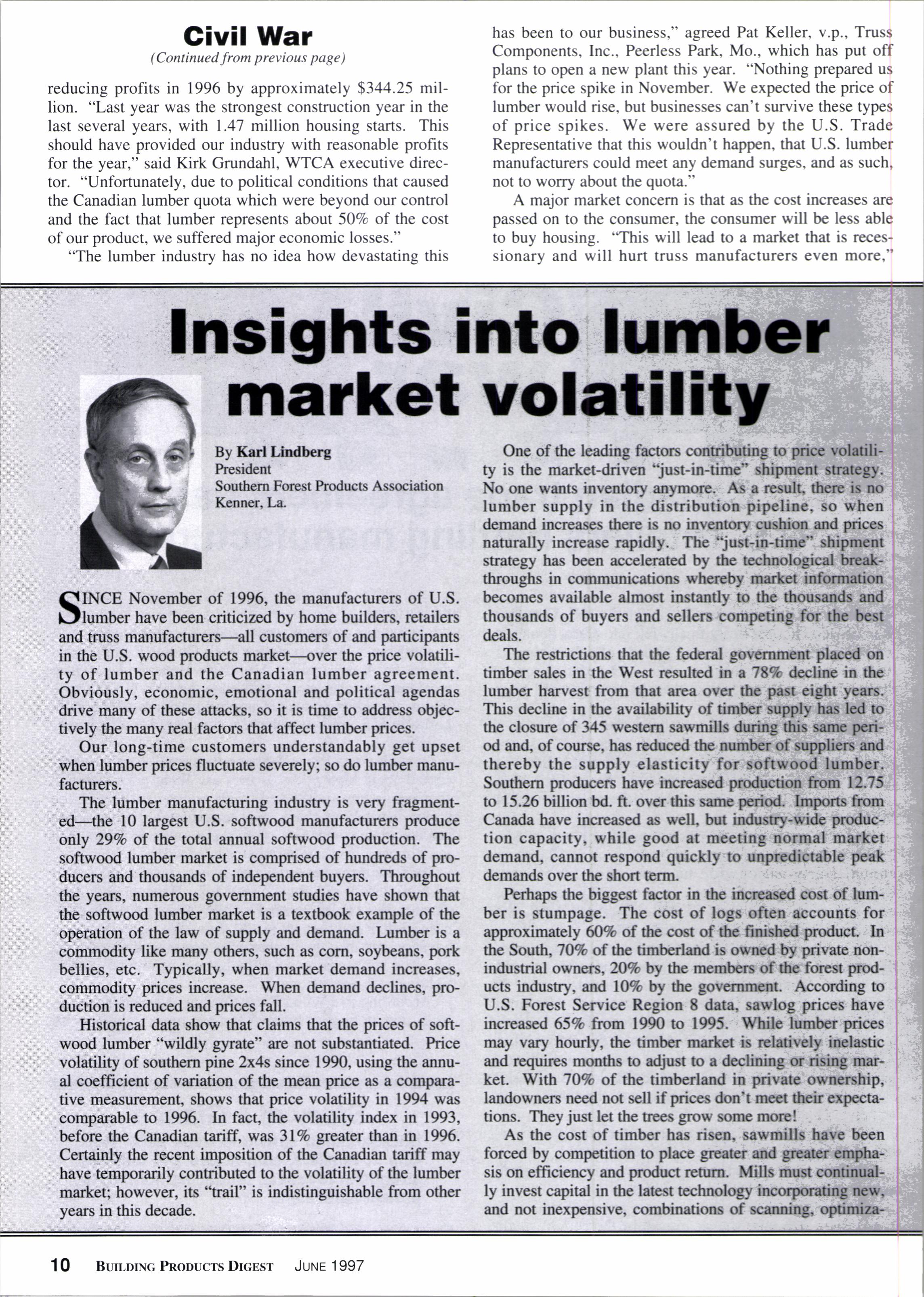
3 minute read
lnsights into lumber market volatility
By Karl Lindberg President
Southern Forest Products Association Kenner. La.
SINCE November of 1996, the manufacturers of U.S. tJlumber have been criticized by home builders. retailers and truss manufacturers-all custonrers of and participants in the U.S. wood products market-over the price volatility of lumber and the Canadian lumber agreentent. Obviously, economic, emotional and political agendas drive many of these attacks. so it is time to address objectively the many real factors that affect lumber pnces.
Our long-time customers understandably get upset when lumber prices fluctuate severely; so do lumber manufacturers.
The lumber manufacturing industry is very fragmented-the l0 largest U.S. softwood manuf-acturers produce only 297c of the total annual softwood production. The softwood lumber market is comprised of hundreds of producers and thousands of independent buyers. Throughout the years, numerous government studies have shown that the softwood lumber market is a textbook example of the operation of the law of supply and demand. Lumber is a commodity like many others. such as corn, soybeans. pork bellies, etc. Typically, when market demand increases. commodity prices increase. When demand declines, production is reduced and prices fall.
Historical data show that claims that the prices of softwood lumber "wildly gyrate" are not substantiated. Price volatility of southern pine 2x4s since 1990. using the annual coefficient of variation of the mean price as a comparative measurement. shows that price volatility in 199.1 was comparable to 1996. In fact, the volatility index in 1993. before the Canadian tariff, was 3lc/c greater than in 1996. Certainly the recent imposition of the Canadian tariff may have temporarily contributed to the volatility of the lumber market: however. its "trail" is indistinsuishable from other years in this decade.
One of the leading factors contributing to price volatility is the market-driven 'just-in-time" shipment strategy. No one wants inventor)' anymore. As a result. there is no lumber supply in the distribution pipeline. so when demand increases there is no inventon- cushion and prices naturally' increase rapidly. The'just-in-time" shipment strateg!'has been accelerated by the technological breakthroughs in communications \rhereby market information beconres arailable almost instantly to the thousands and thousands of buyers and sellers competing for the best deals.
The restrictions that the federal sovernment placed on timber sales in the West resulted in a 18% decline in the lumber harvest from that area over the past eight years. This decline in the availabilitl' of timber supply' has led to the closure of 345 western sawmills durin-s this same period and. of course. has reduced the number of suppliers and thereby the suppll' elasticity' for softwood lumber. Southern producers have increased production from 12.75 to 15.26 billion bd. ft. over this same period. Imports tiom Canada have increased as uell. but industrl'-u'ide production capacitv. rrhile good at meeting normal market demand. cannot respond quickll' to unpredictable peak demands over the short term.
Perhaps the biggest tactor in the increased cost of lumber is stumpage. The cost of lo-es often accounts for approximately 607c of the cost of the tinished product. In the South, l0% of the timberland is ouned by private nonindustrial owners. 20% b_v the members of the forest products industn-. and l0% b;- the gorernment. According to U.S. Forest Service Region 8 data. sawlog prices have increased 657r tiom 1990 to 199-5. While lumber prices may vary hourl;". the timber nrarket is relatively inelastic and requires months to adjust to a declining or rising market. With 70?: of the timberland in private ownership. landou'ners need not sell if prices don't meet their expectations. They just let the trees grou some more!
As the cost of timber has risen. saumills have been forced by competition to place greater and greater emphasis on efficiencl' and product return. Mills must continually invest capital in the latest technolog)'incorporating ne'*'. and not inexpensive. combinations of scanning. optimiza-
Keller explained.
Of course, there are other reasons for the price spikes besides the quota (see story below). One of the greatest is the lockup of federal timberlands, which has placed domestic producers at a disadvantage and continues to threaten the steady flow of supply.
Unfortunately, many retailers, contractors and builders are short-sighted. They all but ignore the environmental crisis, reasoning that if they're not the ones actually cutting the trees, it's not their fight.
Said one multi-state lumber dealer association executive who is mobilizing his members in the civil war over the trade pact: "We wanted a fight that was winnable."










